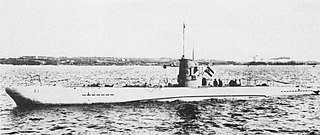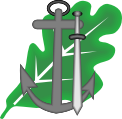
Type VII U-boats were the most common type of German World War II U-boat. 703 boats were built by the end of the war. The lone surviving example, U-995, is on display at the Laboe Naval Memorial located in Laboe, Schleswig-Holstein, Germany.

German submarine U-2 was a Type IIA U-boat of Nazi Germany's Kriegsmarine. Her keel was laid down 11 February 1935 by Deutsche Werke of Kiel as yard number 237; she was launched on 1 July and commissioned on 25 July 1935 with Oberleutnant zur See (Oblt.z.S.) Hermann Michahelles in command.
Vesikko is a submarine, which was launched on 10 May 1933 at the Crichton-Vulcan dock in Turku. Until 1936 it was named by its yard number CV 707. Vesikko was ordered by a Dutch engineering company Ingenieurskantoor voor Scheepsbouw in 1930 as a commercial submarine prototype, being the prototype for the German Type II submarines. Purchased by the Finnish before World War II, she saw service in the Winter War and Continuation War, sinking the Soviet merchant ship Vyborg as her only victory. After the cease-fire with the Allies in 1944, Vesikko was retired. Finland was banned from operating submarines after the war and she was kept in storage until she was turned into a museum ship.

German submarine U-4 was a Type IIA U-boat of Nazi Germany's Kriegsmarine before and during World War II. She was one of the longest lasting German submarines of the period, primarily since half of her time was spent on training duties in the Baltic Sea.

German submarine U-1 was the first U-boat built for Nazi Germany's Kriegsmarine following Adolf Hitler's abrogation of the terms of the Treaty of Versailles in 1935, which banned Germany possessing a submarine force.
German submarine U-63 was a Type IIC U-boat of Nazi Germany's Kriegsmarine that served in the Second World War. She was built by Deutsche Werke AG, Kiel. Ordered on 21 July 1937, she was laid down on 2 January 1939 as yard number 262. She was launched on 6 December 1939 and commissioned on 18 January 1940 under the command of Oberleutnant zur See Günther Lorentz.

German submarine U-3 was a Type IIA U-boat laid down at the Deutsche Werke in Kiel on 11 February 1935 as yard number 238. She was commissioned into the Kriegsmarine on 6 August 1936 under the command of Oberleutnant zur See (Oblt.z.S.) Hans Meckel.

The S-class or Srednyaya submarines were part of the Soviet Navy's underwater fleet during World War II. Unofficially nicknamed Stalinets, boats of this class were the most successful and achieved the most significant victories among all Soviet submarines. In all, they sank 82,770 gross register tons (GRT) of merchant shipping and seven warships, which accounts for about one-third of all tonnage sunk by Soviet submarines during the war.
German submarine U-144 was a Type IID U-boat of Nazi Germany's Kriegsmarine during World War II. She was laid down on 10 January 1940 by Deutsche Werke of Kiel and commissioned on 2 October 1940.

German submarine U-13 was a Type IIB U-boat of Nazi Germany's Kriegsmarine which was commissioned on 30 November 1936, following construction at the Deutsche Werke shipyards at Kiel. The first commander on board was Hans-Gerrit von Stockhausen. In her career she completed nine patrols, all while serving with the 1st U-boat Flotilla. The U-boat succeeded in sinking nine ships and damaging three more.
NV Ingenieurskantoor voor Scheepsbouw, usually contracted to IvS, was a Dutch dummy company set up in The Hague and funded by the Reichsmarine after World War I in order to maintain and develop German submarine know-how and to circumvent the limitations set by the Treaty of Versailles. The company designed several submarine types for paying countries, including the Soviet S-class submarine, as well as the prototypes for the German Type II submarines and Type VII submarines.
German submarine U-58 was a Type IIC U-boat of Nazi Germany's Kriegsmarine that served in the Second World War. She was produced by Deutsche Werke AG, Kiel. Ordered on 17 June 1937, she was laid down on 29 September as yard number 257. She was launched on 12 October 1938 and commissioned on 4 February 1939 under the command of Oberleutnant zur See Herbert Kuppisch.
German submarine U-59 was a Type IIC U-boat of Nazi Germany's Kriegsmarine that served in the Second World War. She was built by Deutsche Werke AG, Kiel. Ordered on 17 June 1937, she was laid down on 5 October as yard number 258. She was launched on 12 October 1938 and commissioned on 4 March 1939 under the command of Oberleutnant zur See Harald Jürst.
German submarine U-60 was a Type IIC U-boat of Nazi Germany's Kriegsmarine that served in the Second World War. She was built by Deutsche Werke AG, Kiel. Ordered on 21 July 1937, she was laid down on 1 October that year as yard number 259. She was launched on 1 June 1939 and commissioned on 22 July under the command of Oberleutnant zur See Georg Schewe.
German submarine U-61 was a Type IIC U-boat of Nazi Germany's Kriegsmarine that served in the Second World War. It was built by Deutsche Werke AG, Kiel. Ordered on 21 June 1937, it was laid down on 1 October as yard number 260. It was launched on 15 June 1939 and commissioned on 12 August under the command of Oberleutnant zur See Jürgen Oesten.
German submarine U-142 was a Type IID U-boat of Nazi Germany's Kriegsmarine during World War II. Her keel was laid down on 12 December 1939 by Deutsche Werke in Kiel as yard number 271. She was launched on 27 July 1940 and commissioned on 4 September 1940 with Oberleutnant zur See Asmus Nicolai Clausen in command.
German submarine U-146 was a Type IID U-boat of Nazi Germany's Kriegsmarineduring World War II. Her keel was laid down on 30 March 1940 by Deutsche Werke in Kiel as yard number 275. She was launched on 21 September 1940 and commissioned on 30 October with Eberhart Hoffmann in command.
German submarine U-148 was a Type IID U-boat of Nazi Germany's Kriegsmarine during World War II. Her keel was laid down on 10 April 1940 by Deutsche Werke in Kiel as yard number 277. She was launched on 16 November 1940 and commissioned on 28 December with Oberleutnant zur See Hans-Jürgen Radke in command.
German submarine U-151 was a Type IID U-boat of Nazi Germany's Kriegsmarine during World War II. Her keel was laid down on 6 July 1940 by Deutsche Werke in Kiel as yard number 280. She was launched on 14 December 1940 and commissioned on 15 January 1941 with Kapitänleutnant Hans Oestermann in command.
German submarine U-152 was a Type IID U-boat of Nazi Germany's Kriegsmarine during World War II. Her keel was laid down on 6 July 1940 by Deutsche Werke in Kiel as yard number 281. She was launched on 14 December 1940 and commissioned on 29 January 1941 with Kapitänleutnant Peter-Erich Cremer in command.








